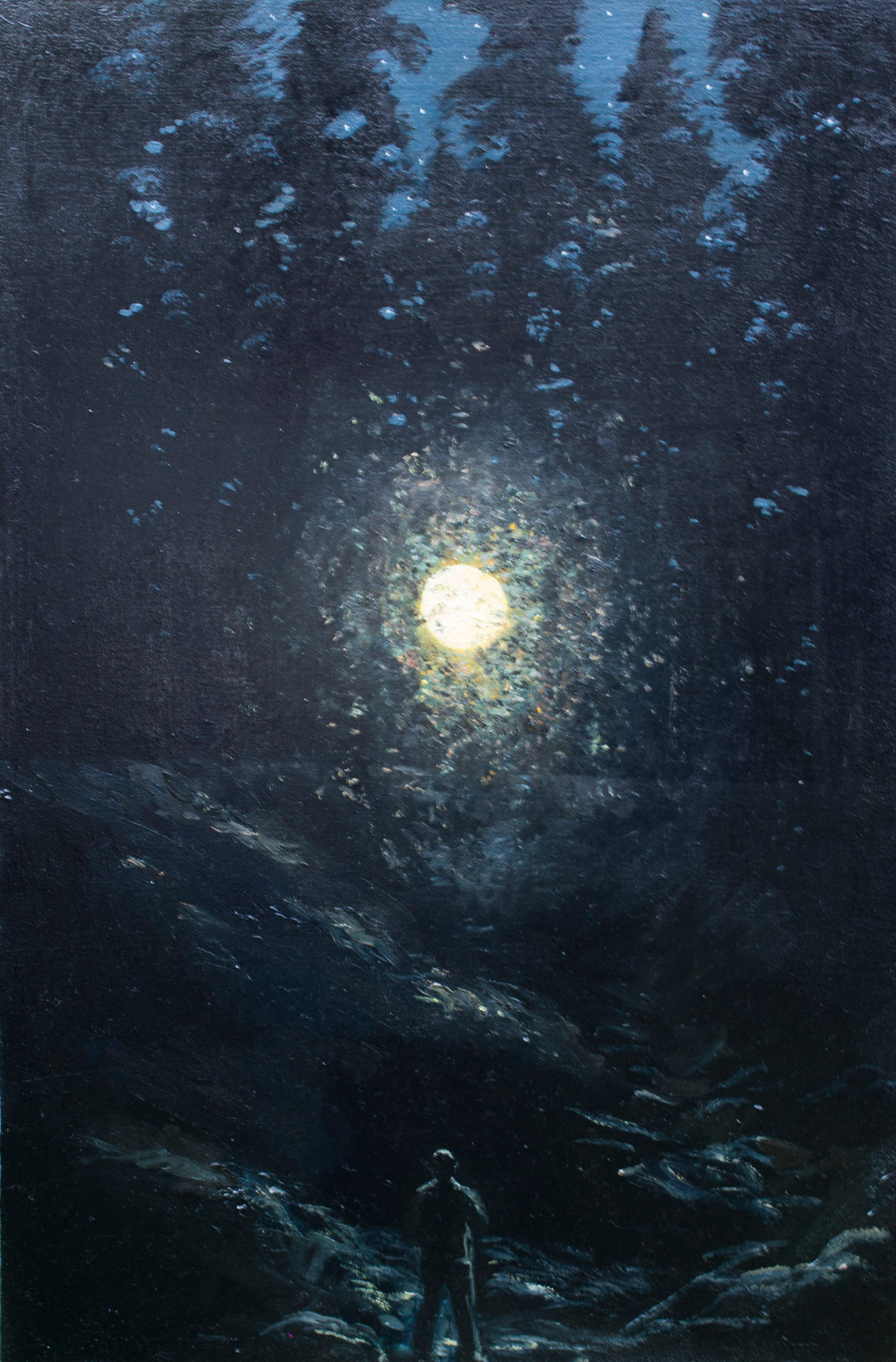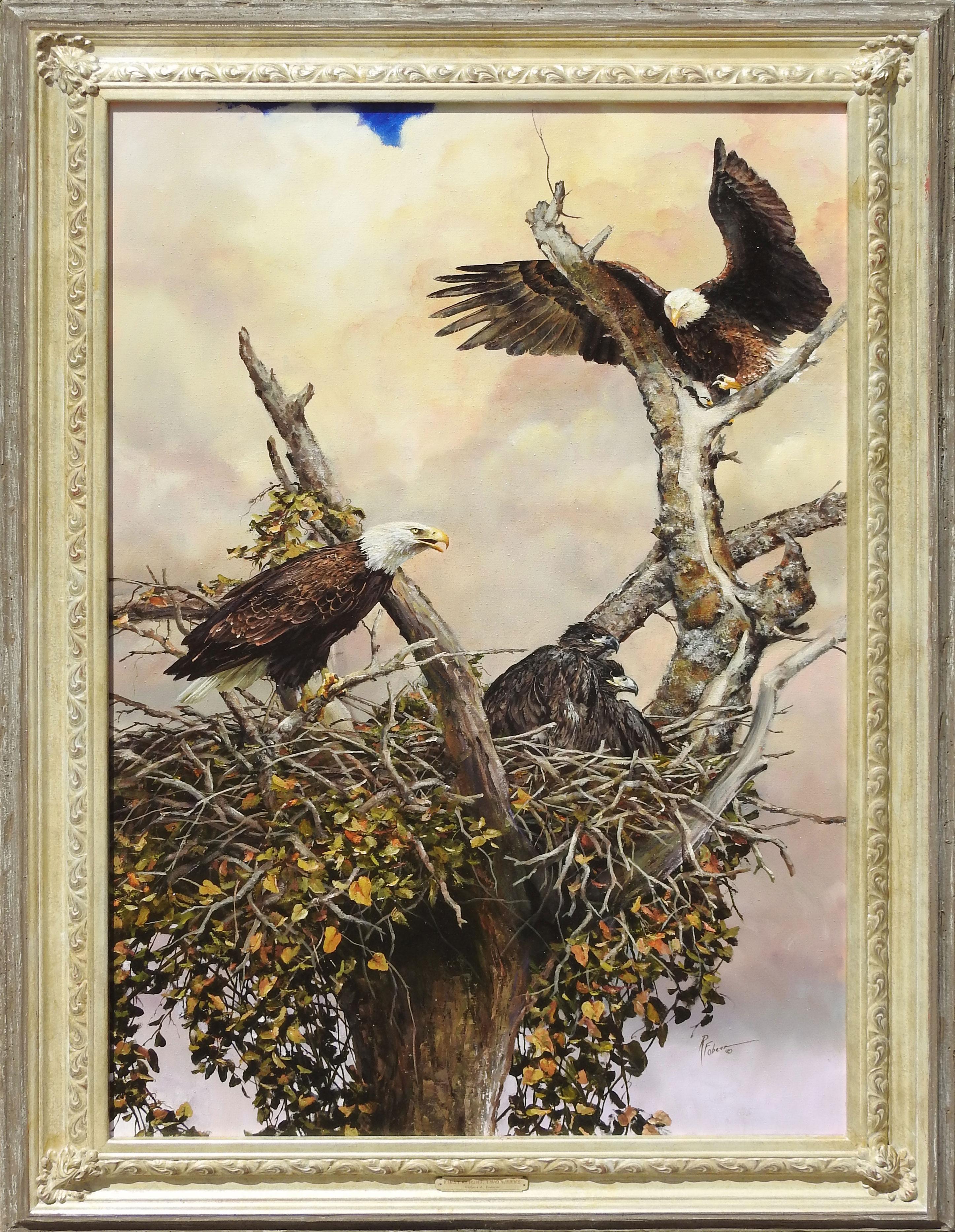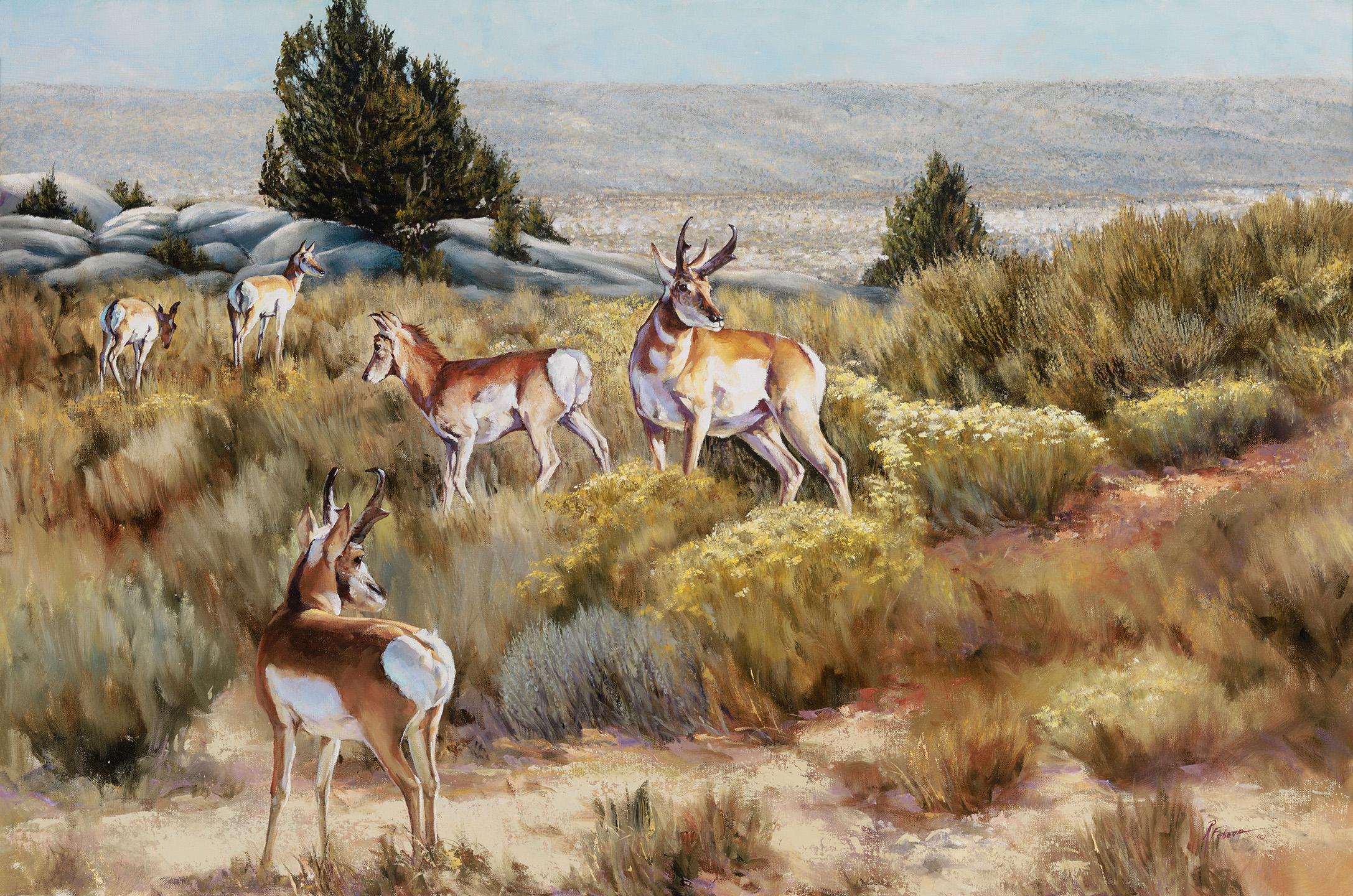Items Similar to 19th Century Hudson River School Bucolic Landscape
Want more images or videos?
Request additional images or videos from the seller
1 of 11
19th Century Hudson River School Bucolic LandscapeCirca 1875
Circa 1875
About the Item
Beautiful example of the Hudson River School romantic bucolic New York autumn landscape with cows foraging. Illegible artist signature on stretcher bar (See enhanced images). Condition: very good; professionally cleaned and minor restoration upper right hand corner where paint was missing.
Unframed.
Image size: 14"H x 24"W x .75"D
Hudson River School was an informal association was America's first so-called school of painting and the dominant landscape style until the Civil War. The name derives from a group of 19th-century landscape painters working in New York state. With realistic composition, they depicted romantic views of unsettled areas of the Hudson River Valley especially lakes, rocky gorges, and forests in the Catskill Mountains. About a fourth of these artists utilized luminism or effects with special lighting techniques to convey lofty emotions through contrasts of light and dark. Included in this Hudson River luminist category were Washington Allston, Albert Bierstadt, William Hart, and Frederic Edwin Church.
Thomas Cole is considered the leader of the movement, which began in 1825 when other artists, including Asher Durand, discovered Cole's landscapes whose loftiness and sense of high drama suggested communication with God through nature. For Cole and later his followers, the landscape was a sacred place.
An American art journal called The Crayon, published between 1855 and 1861, reinforced the Hudson River School painters and promoted the idea that nature was a healing place for the human spirit. Hudson River painters, including Asher Durand, contributed to this publication as did men of literature such as Ralph Waldo Emerson, William Cullen Bryant, and James Fennimore Cooper, all of them promoting the idea that nature and God were one.
Hudson River School adherents including Asher Durand and Frederic Edwin Church often did panoramic views in a romantic, semi-realist style, with an underlying mood of serenity and contemplation. After the Civil War, Impressionism and other revolutionary styles, originating in Europe, usurped Hudson River School painters as the dominant influence on American landscape painting.
The School is credited, however, with making landscape for the first time a legitimate subject for canvas and for conveying a sense of place that was uniquely American. Although the compositional and stylistic devices were Old World---at least 36 of the Hudson River artists had been trained in European academies---the subject matter infused Americans with the confidence to turn away from European subjects to their own culture. And today, works by certain members of the Hudson River School remain strong in the market place with leaders being Martin Heade, Thomas Cole, Frederic Church, George Inness, and Albert Bierstadt.
- Creation Year:Circa 1875
- Dimensions:Height: 14 in (35.56 cm)Width: 24 in (60.96 cm)Depth: 0.75 in (1.91 cm)
- Medium:
- Movement & Style:
- After:John Frederick Kensett (1816-1872, American)
- Period:
- Condition:Very good, professionally cleaned and minor restoration upper right hand corner where paint was missing.
- Gallery Location:Soquel, CA
- Reference Number:
About the Seller
4.9
Platinum Seller
These expertly vetted sellers are 1stDibs' most experienced sellers and are rated highest by our customers.
Established in 1986
1stDibs seller since 2014
2,517 sales on 1stDibs
Typical response time: <1 hour
- ShippingRetrieving quote...Ships From: Soquel, CA
- Return PolicyA return for this item may be initiated within 14 days of delivery.
More From This SellerView All
- New England Autumnal Bucolic Landscape -- Cows by the Watering Hole 19th CenturyLocated in Soquel, CAGorgeous late 19th Century landscape of cows near watering hole with birch trees and puffy clouds in background by Wesley John Straight (American, 1855 - 1922). Signed lower left corner and on verso. Title "Autumn in New England" on verso lower stretcher bar. Condition: Good; professionally cleaned and restored; minor abrasions repaired and in-painted (see images). Unframed. Image size: 40"H x 32"W. Born in Wisconsin on May 20, 1855. Straight appears to have migrated to northern California in the late 1870s. While a resident of San Jose and Grass Valley, he painted scenes of the northern coast and other scenic spots. After moving to southern California in 1912, he lived at the Southern Hotel in San Bernardino until his demise on April 5, 1922. Exhibitions: Delavan Wisconsin County Fair 1874 (painting of the Wisconsin State School for the deaf and countryside), Calif. State Fair, 1880-90, Placer California 1880...Category
1890s American Impressionist Landscape Paintings
MaterialsLinen, Oil
- Early 20th Century Study of Jean Leon Gerome Ferris' Lion -- The Two MajestiesBy Jean Leon Gerome FerrisLocated in Soquel, CAWonderful early 20th Century study of Jean Leon Gerome Ferris's 1885 Lion and Sun landscape "The Two Majesties." Unsigned. Condition: One tear professiona...Category
1920s Impressionist Animal Paintings
MaterialsLinen, Oil
- "Noah's Ark", Monkeys in Trees w. Crocodiles, Richard DeTreville 1924 San MateoBy Richard DeTrevilleLocated in Soquel, CA"Noah's Ark", Monkeys in Trees w. Crocodiles, Richard DeTreville 1924 San Mateo A lively, large-scale vertical painting of Macaques monkeys in the trees abo...Category
1920s American Impressionist Landscape Paintings
MaterialsOil, Linen
- Large Scale Early 20th Century Bucolic Mt. Hood LandscapeBy William M. LemosLocated in Soquel, CAGorgeous landscape with two cows drinking water in a pond with Mt. Hood in background by listed artist William M. Lemos (American, 1861-1942). Signed "W.M. Lemos" lower right. Presented in vintage gilt-toned frame that shows wear (included as-is). Condition: Good: previously owned and used, with little or no signs of wear and is in good condition. No structural issues. Image size: 29"H x 49"W. Born in New York, Professor Lemos moved to San Francisco in 1887 where he established a studio at 106 Geary Street. He later moved to Santa Cruz in 1896, where he settled, painting murals for many local businessmen and the Santa Cruz Beach Boardwalk. As a boy Lemos earned money by wandering the streets and painting on request. Arriving in San Francisco in 1887, he established a studio at 106 Geary. With his wife Mabel, he worked in Los Angeles for a few years in the 1890s. After settling in Santa Cruz in 1896, he painted murals for many local businessmen. When the original Beach Casino was built there at the Boardwalk in 1904, Lemos was the first concessionaire and worked there for nearly 40 years. On his platform in the Casino, Lemos did paintings of redwoods, still lifes, forest fires, beach scenes, and marines. Many of his oils were done on redwood slabs which were popular with the tourists; in the early days these paintings sold for one dollar and up depending on the size of the work. After his vision failed and he was unable to paint, his last years were mostly spent fishing off the Municipal Pier with a friend who baited his hook for him because he could no longer see. In the March 27, 1941 Santa Cruz Sentinel News Lemos reminisced, "Them were the days when the Boardwalk was only twelve feet long and when business got slow I picked up my shotgun and went across the street and shot ducks where the Casa del Rey Hotel now stands." Exhibited: Calif. State Fair, 1885; Mechanics' Inst. (SF), 1889. In: Santa Cruz City Museum; Wawona Hotel (Yosemite). Edan Hughes, "Artists in California, 1786-1940" His mother was Julia Lemos, a Chicago artist famous for her depiction of the Chicago fire, “Two of Julia’s children became successful artists. Her eldest son, William, was a naïve still life, landscape, and mural painter. As a young boy in New York, he would wander the streets, earning money for the family, by ‘painting on request.’ At age 26, William moved to San Francisco, California. He opened an art studio and kept it running until he moved to Santa Cruz with his wife, Mabel, in 1896. During this period, he worked as a fresco artist painting ‘murals for many local businessmen.’ Exhibited California State Fair, Sacramento, 32nd annual, per Sacramento Daily Union, September 9, 1885. and article goes on to say “William Lemos and wife, Sacramento – Art school exhibits in which are shown such a variety of designs in decorative art, flower painting, and ornamentation, that one must give time to the examination.” Exhibited Mechanics Institute, San Francisco, 1889. “Lemos and his wife were in Fresno California 1890...Category
Early 20th Century American Impressionist Landscape Paintings
MaterialsCanvas, Oil
- Rounding Up the Horses - CaballeroLocated in Soquel, CADynamic depiction of a rider with a group of horses near the water's edge. Several horses are in for foreground, running towards the viewer. Just behind them, a rider in American col...Category
Mid-20th Century Impressionist Landscape Paintings
MaterialsCanvas, Oil
- Early 20th Century Landscape Bear and EagleLocated in Soquel, CACharming naive mountain landscape with bear and soaring eagle by R. Ramberg (American, 19/20th Century), 1933. Signed and dated center lower edge. Presented in rustic wood frame. Im...Category
1930s American Impressionist Landscape Paintings
MaterialsCanvas, Oil
You May Also Like
- Gordon Setter in a Landscape by Otto Norquist (American: 1859-1906)Located in New York, NYOtto Norquist (1859-1906) "Gordon Setter in a Landscape, 1890" Oil on canvas 22 x 27 inches Signed and dated 1890, lower right Otto Norquist was born in...Category
Late 19th Century Hudson River School Landscape Paintings
MaterialsOil, Canvas
- Deer in the ForestLocated in New York, NYSigned and dated lower right: • FARNY • /88Category
Mid-19th Century Hudson River School Landscape Paintings
MaterialsWatercolor, Gouache
- Luna 1By Erik PerezLocated in Mexico City, CDMXAn innate and atypical landscape artist, Eric Pérez is an intellectual who paints. He knows and loves Mexican and world history, from which he derives his contemporary context. His p...Category
2010s Conceptual Animal Paintings
MaterialsLinen, Oil
- "Calling for Rain", Robert Fobear, Original Oil on Canvas, 60x48, Wildlife BirdsBy Robert FobearLocated in Dallas, TX"Calling for Rain" is an original oil on linen painting by Texas Artist Robert Fobear and measures 60x48 inches. This stunning piece captures the essence of autumn with its vibrant g...Category
2010s Realist Animal Paintings
MaterialsLinen, Oil
- "First Flight, Two Weeks", Robert Fobear, Original Oil, 60x40, Wildlife, EagleBy Robert FobearLocated in Dallas, TX"First Flight, Two Weeks" is an original oil on linen painting by Texas Artist Robert Fobear and measures 40x60 inches. This extraordinary piece captures a mesmerizing autumn scene, ...Category
2010s Realist Animal Paintings
MaterialsOil, Linen
- "Wyoming", Robert Fobear, Original Oil on Canvas, 40x60, Pronghorn AntelopeBy Robert FobearLocated in Dallas, TX"Wyoming" is an original oil on linen painting by Texas Artist Robert Fobear and measures 40x60 inches. The painting features the majestic pronghorn antelope traversing through the dry and rugged terrain of the wilderness. Fobear's exceptional attention to detail and his ability to capture the essence of the natural world is on full display in this stunning piece. Art enthusiasts and wildlife lovers alike will be captivated by the intricate and lifelike depiction of these magnificent creatures. The piece is also completed in a black rustic...Category
2010s Realist Animal Paintings
MaterialsLinen, Oil





